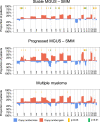Whole-genome sequencing reveals progressive versus stable myeloma precursor conditions as two distinct entities
- PMID: 33767199
- PMCID: PMC7994386
- DOI: 10.1038/s41467-021-22140-0
Whole-genome sequencing reveals progressive versus stable myeloma precursor conditions as two distinct entities
Abstract
Multiple myeloma (MM) is consistently preceded by precursor conditions recognized clinically as monoclonal gammopathy of undetermined significance (MGUS) or smoldering myeloma (SMM). We interrogate the whole genome sequence (WGS) profile of 18 MGUS and compare them with those from 14 SMMs and 80 MMs. We show that cases with a non-progressing, clinically stable myeloma precursor condition (n = 15) are characterized by later initiation in the patient's life and by the absence of myeloma defining genomic events including: chromothripsis, templated insertions, mutations in driver genes, aneuploidy, and canonical APOBEC mutational activity. This data provides evidence that WGS can be used to recognize two biologically and clinically distinct myeloma precursor entities that are either progressive or stable.
Conflict of interest statement
The authors declare no competing interest.
Figures






Similar articles
-
Defining genomic events involved in the evolutionary trajectories of myeloma and its precursor conditions.Semin Oncol. 2022 Feb;49(1):11-18. doi: 10.1053/j.seminoncol.2022.01.006. Epub 2022 Jan 31. Semin Oncol. 2022. PMID: 35168813 Free PMC article. Review.
-
Updates on mechanisms of disease progression in precursor myeloma: Monoclonal gammopathy of undermined significance and smoldering myeloma.Presse Med. 2025 Mar;54(1):104268. doi: 10.1016/j.lpm.2025.104268. Epub 2025 Jan 18. Presse Med. 2025. PMID: 39832697 Review.
-
Advances in MGUS diagnosis, risk stratification, and management: introducing myeloma-defining genomic events.Hematology Am Soc Hematol Educ Program. 2021 Dec 10;2021(1):662-672. doi: 10.1182/hematology.2021000303. Hematology Am Soc Hematol Educ Program. 2021. PMID: 34889381 Free PMC article. Review.
-
Changing paradigms in diagnosis and treatment of monoclonal gammopathy of undetermined significance (MGUS) and smoldering multiple myeloma (SMM).Leukemia. 2020 Dec;34(12):3111-3125. doi: 10.1038/s41375-020-01051-x. Epub 2020 Oct 12. Leukemia. 2020. PMID: 33046818 Review.
-
Stromal alterations in patients with monoclonal gammopathy of undetermined significance, smoldering myeloma, and multiple myeloma.Blood Adv. 2024 May 28;8(10):2575-2588. doi: 10.1182/bloodadvances.2023011632. Blood Adv. 2024. PMID: 38241490 Free PMC article.
Cited by
-
The Urgent Need for Precision Medicine in Cancer and Its Microenvironment: The Paradigmatic Case of Multiple Myeloma.J Clin Med. 2022 Sep 16;11(18):5461. doi: 10.3390/jcm11185461. J Clin Med. 2022. PMID: 36143110 Free PMC article.
-
Multiple Myeloma: Molecular Pathogenesis and Disease Evolution.Oncol Res Treat. 2021;44(12):672-681. doi: 10.1159/000520312. Epub 2021 Nov 8. Oncol Res Treat. 2021. PMID: 34749378 Free PMC article. Review.
-
Risk Stratification and Treatment in Smoldering Multiple Myeloma.Cells. 2021 Dec 31;11(1):130. doi: 10.3390/cells11010130. Cells. 2021. PMID: 35011692 Free PMC article. Review.
-
Biological and clinical determinants shaping heterogeneity in mantle cell lymphoma.Blood Adv. 2024 Jul 23;8(14):3652-3664. doi: 10.1182/bloodadvances.2023011763. Blood Adv. 2024. PMID: 38748869 Free PMC article. Review.
-
Genome Instability in Multiple Myeloma: Facts and Factors.Cancers (Basel). 2021 Nov 26;13(23):5949. doi: 10.3390/cancers13235949. Cancers (Basel). 2021. PMID: 34885058 Free PMC article. Review.
References
Publication types
MeSH terms
Grants and funding
LinkOut - more resources
Full Text Sources
Other Literature Sources
Medical

